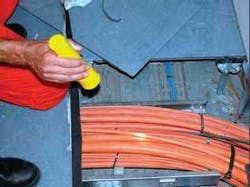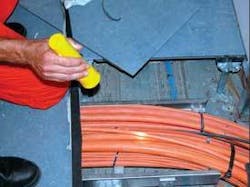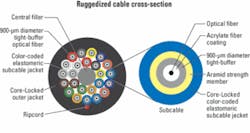Ruggedized, high-performance cables increase bandwidth in the factory
by David Rizzo
Forget the polo shirt, slacks, and Rockports. Today’s user of high-speed communication links is just as likely to wear overalls, a hard hat, and boots. With the need to collect and move data at gigabit speeds in industrial applications, high-performance fiber-optic cable is increasingly migrating from the cool confines of air-conditioned office buildings and data centers into the hothouse, rough and tumble environment of steel mills, oil refineries, and chemical plants.Under such harsh conditions, the ruggedness and durability of fiber-optic cables can come into question. Whereas typical loose-tube or “indoor” tight-buffered cables might suffice for some simple, noncritical applications, today’s plant managers now demand high-quality, abuse-resistant, tight-buffered fiber-optic cables that offer exceptional bend, crush, impact, and chemical resistance across a broad thermal operating range. The goals: speed installation, reduce attenuation loss, and maximize “up time.”
Almost as old as glass fiber itself, loose-tube fiber-optic cable still finds use in some commercial and industrial enterprise applications and for many long-haul backbones-if only because of its relatively low cost. These same enterprise niches also see the use of inexpensive, low-quality, indoor-rated tight-buffered cables. But when juxtaposed against the demanding needs of today’s industrial plant, which calls for maximum durability and fail-safe operation, then any temporary cost savings vanish in the economic consequences of interrupted processes or halted manufacturing runs caused by data loss or cable failure. As the cost of cabling represents a small fraction of a communication system (when factoring in the network equipment, cable connectivity hardware, and installation and testing), a 10% to 20% price premium for ruggedized tight-buffered cable amounts to a cost increase of only a few percentage points. On the other hand, skimping on cable quality may end up costing many thousands of dollars per minute in system downtime, especially for critical applications.
Ruggedized, tight-buffered fiber-optic cable derives much of its reliability and performance advantages from its basic design (see figure). As opposed to loose-tube designs, which only have one thin coating surrounding each optical fiber, ruggedized tight-buffered fibers have two. In loose-tube cable designs, the fiber coating is only 62 µm thick, providing minimal mechanical and environmental protection to the glass fiber during cable handling and stress. In addition to the primary fiber coating, each tight-buffered fiber has a secondary buffer that, together with the primary coating, reaches “heavy weight” proportions such as 387 µm. This is more than 6× thicker than the primary coating alone. Several of these individual buffered fibers are then tightly bundled within a sturdy cable jacket to create a ruggedized unit that is highly water resistant by virtue of the tight bundling and special fiber coatings.
For exceptionally demanding applications, some cable manufacturers customize the cable with additional jacketing and strengthening of each fiber subunit prior to final cable jacketing (i.e., breakout cables), further enhancing the design’s ability to exhibit low loss in the face of extreme operating temperature ranges and extraordinary mechanical stress.
Loose-tube designs-with their fragile, thinly coated fibers contained in a rigid hollow tube-can’t begin to compete in the harsh environments often encountered in today’s factory settings. Being relatively stiff and inflexible, loose-tube cables can develop jacket splits and breaks from flexure and abrasion that can allow water penetration, ultimately damaging the fiber. Tight bends or kinks in the tube can actually collapse the cable and break the fibers. Even some indoor-rated tight buffered cables can suffer from degradation or failure, caused by both long-term abuse and installation assaults.
Finding fiber-optic cables that can withstand the mistreatment handed out by manufacturing plants, petrochemical refineries, oil and gas platforms, mining sites, seismic testing facilities, military operations, remote video broadcasts, and transportation and security systems now requires taking a magnifying glass to even tight-buffered cables. Identifying the subtle differences that allow one cable design to succeed, while another fails, over the life of the installation begins by taking into account the two most common stresses to which fiber-optic cable is subjected: installation stress and long-term environmental and mechanical stress.
Unlike some long-haul applications, where the cable is basically dropped into the ground and covered with dirt with minimum connectorization, the placement of fiber within a factory requires countless bends, pulls, and connections. All of this poses a risk to the cable. Here, loose tube designs can quickly fail. Even low-quality tight-buffered cable can break while being pulled through and around the multiple walls, ceilings, gantries, tanks, and material handling systems commonly found in industrial sites. In the face of such obstacles, only ruggedized tight-buffered cables can stand up to the stress.
For the most part, if major cable stress or damage occurs during the installation process, the contractor presumably knows about it right away and will quickly fix or replace the damaged link.
More insidious, though, is the “microbend,” or residual stress, that can occur during or after installation. Often too small to notice initially, the cumulative stresses wreaked upon cable during rough handling can return to haunt the plant via higher-loss transmissions, missing data, and broken fibers. At worst, a complete shutdown in the communications link can occur.
Additionally, instrumentation and control engineers are increasingly demanding 10-Gbit/sec transmission for certain links within the factory environment, requiring the latest 50-µm multimode OM3 fiber, and in some cases, singlemode fiber. However, OM3, 50-µm, and singlemode fibers are much more bend-sensitive than the previous generation of 62.5-µm fibers-hence requiring cable quality that goes well beyond minimum standards.
Specially selected materials and advanced manufacturing processes can help ensure that 10-Gbit/sec cabling can withstand deployment in the most demanding industrial environments.
Once installed within a factory, the integrity of cable runs remains anything but stable as harsh environments and even gravity can play havoc. If anything, today’s use of 10-Gbit/sec communication links increasingly brings to light the fragility of all but the sturdiest of fiber-optic cables. Even after installation, any kind of stress, whether minor mechanical loads or temperature extremes, can result in microbends or other fiber stresses that in turn may lead to increased cable loss and transmission errors, or even eventual fiber failure and breakage.For instance, having other heavy cables lying on top of the high-speed link within a cable tray can cause cumulative trauma to the glass fibers. Even within vertical runs, cable is subject to stress. Gravity may cause axial migration that slowly weakens the fiber until a perfectly good installation degrades to the point where the link no longer functions.
Consider that 1-Gbit/sec lengths (distance-limited to about 300 m) and OM3 10-Gbit/sec lengths (often used to extend 1-Gbit/sec links to more than 1,000 m) have less than 43 dB of total allowable channel insertion loss (as per the IEEE 802.3 Ethernet specification), and it becomes obvious that even the slightest increase in attenuation can sabotage the communication link.
All the more reason why only the best designed, tight-buffered, tight-bound, ruggedized fiber-optic cable will ultimately survive the longest in industrial applications. For example, a pressure-extruded or tightly bound outer jacket that firmly binds all the fibers together enables the cable to move as a single, solid, rope-like unit. Some of these cables greatly exceed minimum industry-standard requirements with flex resistance of thousands of cycles, crush resistance of 2,200 N/cm, the ability to withstand 1,000 impacts, and tensile load rating exceeding a ton.
Further qualifying themselves for industrial application, the latest generation of ruggedized fiber-optic cables withstands environmental insults such as caustic and volatile chemicals, excessive moisture and fungus, UV exposure, and operating temperatures ranging anywhere from -55° to +124°C. Under such circumstances, the value of high-quality, ruggedized, tight-buffered fiber-optic cables helps industrial plants take advantage of the ultrahigh-speed links once reserved for white-collar campus networks and data centers.David Rizzo writes technical articles for Optical Cable Corp. (www.occfiber.com), based in Roanoke, VA. He has published two trade books, 150 technical articles, and 300 newspaper columns.


